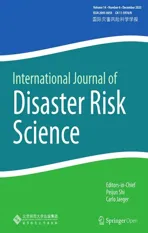The Dynamics of Interorganizational Collaboration in Disaster Management: A Network Study Based on Flood Disasters in China
2023-02-26ZhichaoLiLongLiuShaodanLiu
Zhichao Li · Long Liu · Shaodan Liu
Abstract Interorganizational collaboration networks have become an important tool for disaster management.However, research on how dif ferent organizations can ef fectively collaborate throughout the entire disaster management process in centralized states such as China is scarce.This study begins to f ill this lacuna by investigating interorganizational collaboration in dif ferent phases of disaster management and analyzing changes in the structure of the networks constructed during the preparedness and response phases of the 2020 f lood disaster in Hubei Province, China.Building on the complex adaptive systems (CAS)theory, we argue that interorganizational collaboration changes dynamically according to its tasks and requirements.In the preparedness phase, interorganizational collaborations primarily follow established plans and choose horizontal selforganized collaboration mechanisms.However, when the urgent information and resource requirements increase in the response phase, many organizations choose vertical mandatory collaboration mechanisms.We found that organizations at the central and provincial levels in China were well positioned to coordinate information and resources and strengthen the interorganizational collaboration and communication that is crucial in disaster management.These f indings contribute to the study of interorganizational collaboration networks in disaster management.
Keywords China · Complex adaptive system · Disaster management · Flood disasters · Interorganizational collaboration ·Social network analysis
1 Introduction
Because disaster management often exceeds the resources and capabilities of government agencies, in addition to the command and control method between government organizations, interorganizational cooperation and collaboration networks are commonly employed to respond to disasters both in China and internationally (Kapucu and Hu 2016;Tao and Zhang 2023).An increasing amount of related research has proved the essential role of interorganizational collaboration networks among government agencies, private organizations, non-prof it organizations, and businesses in disaster management (Comfort et al.2012; Kapucu and Garayev 2016).However, considering the various tasks and requirements in the disaster mitigation, preparedness,response, and recovery phases, more research is needed to address the mechanism, structure, and network ef ficiency of interorganizational collaboration networks throughout the entire process of disaster management.
From the organizational perspective, f irst, the number of organizations and the types of interactions among organizations will vary in dif ferent disaster management phases,which can change the network structure and af fects the efficiency of interorganizational collaborative networks(Kapucu and Hu 2016).Second, time and ef fort are required to form and build collaboration among organizations in disaster management.Specif ically, ef fective communication information, the trust and social capital among organizations before disasters, and the engagement of organizations in disaster management planning are all important for maintaining and sustaining interorganizational collaborations (Hu et al.2014).
From the network perspective, f irst, to address the complex and dynamic interorganizational collaboration process in disaster management, increasingly researchers adopt the complex adaptive systems (CAS) theory to explore the characteristics of interorganizational collaboration networks in disaster management.Comfort and Zhang ( 2020) identif ied that interorganizational collaboration networks have at least three types of changes throughout the disaster management process: adaptation, which means that the structure of the network changes to better respond to disasters based on the changed context; emergence, which indicates the new actions and information emergent in the network to respond to the urgent needs or requirements of the disaster; and integration, which denotes the process to merge the emergent new actions and information into the existing network to improve the network ef ficiency to meet the demands of disasters.Second, Kapucu and Garayev ( 2016) stated that the vertical and horizontal network structure will af fect the ef ficiency of the interorganizational collaboration networks in disaster management.
In addition, there is currently insuf ficient research to explore the interorganizational collaboration networks of disaster management in China.Considering the centralized governance context in China, the interorganizational collaboration networks for disaster management can be divided into three main types: the planned networks, which are mainly formed based on the authority and responsibilities of governmental organizations and other actors before disasters; the emergent networks, which are mainly built based on the urgent need to respond to disasters without planning; and the operational networks, which combine both the authority and the adaptability of the planned and the emergent networks (Comfort and Zhang 2020; Tao and Zhang 2023).
According to statistics from the Ministry of Emergency Management of the People’s Republic of China, natural hazards and disasters af fected 138 million people, left 591 people dead or missing, and caused economic losses of more than USD 51.6 billion in 2020 (Ministry of Emergency Management of China 2021).The Yangtze River and the Yellow River Basins f lood every year, making f lood disaster management a priority at all levels of government.Therefore,this research employed the social network analysis (SNA)method to compare the characteristics and analyze the mechanisms of interorganizational collaboration networks in the disaster preparedness and disaster response phases based on the f loods in China.
China is a centralized unitary state with a hierarchical emergency management system, ascending in authority from the county, city, province, and central government levels.The provincial and central governments are generally known as higher levels of government, while the rest are considered local governments.Disaster management organizations are guided by the principle of “hierarchical responsibility and local management.” The “hierarchical responsibility”involves the dif ferent levels of government identifying and gauging the severity of the disaster and deciding whether and how to respond.“Local management” means that regardless of the involvement or orders from above, the local governments (county and city) are responsible for most of the disaster management tasks.When a disaster area expands, the higher levels of government provide guidance, coordination,support, and assistance by sending working and assistance groups, among others.
After f loods break out, the enormously destructive and cross-territorial nature of f lood disasters requires both vertical guidance and support from dif ferent levels of government and horizontal cross-territorial cooperation from local governments and other volunteer organizations.How do the interorganizational collaboration networks operate during the f lood disaster preparedness and response phases? How will the interorganizational collaboration network structure evolve throughout the f lood process? Furthermore, how do organizations cooperate in dif ferent phases of disaster management so the interorganizational collaboration network can do the “right thing at the right time”? Answering these questions has important theoretical and practical implications for improving disaster management operations in China.
This study examined the changes in the characteristics and structure of interorganizational collaboration networks in the disaster preparedness and response phases, paying particular attention to vertical and horizontal collaboration among organizations before and after disasters.Specif ically,we compiled textual data on governmental organizational cooperation and used SNA to examine the interorganizational collaboration networks during the disaster preparedness and response phases of f lood disasters in Hubei Province, China.We analyzed two core variables—horizontal and vertical linkages—to identify changes in the organizational collaboration mechanisms during the network’s evolution.We then conducted quadratic assignment procedure (QAP) regression empirical tests for robustness and objectivity, incorporating geographic, economic, and demographic information into the model.
2 Interorganizational Collaboration in Disaster Management
Interorganizational collaboration networks emerge when multiple organizations work together to reach goals they cannot achieve independently and efficiently (Agranoff and McGuire 2001).However, there is no consensus on the most ef fective interorganizational collaboration method in disaster management (Guo et al.2021).Some researchers argue that the best disaster management ef forts involve vertical collaboration or cooperation networks among dif ferent organizations and rely on enforcement from authorities as established in advance (Hunt et al.2014).But Waugh and Streib ( 2006) argued that vertical and hierarchical collaboration networks lacked f lexibility and ef fective information and resource sharing among organizations during disasters.Other scholars believe that the most adaptable and f lexible network environment for cooperation in disaster management involves horizontal, multiorganizational collaboration networks and a solid relationship among dif ferent organizations and jurisdictions (Boin and Hart 2003).Considering the special context in China, interorganizational collaboration networks can be divided into three main categories:the planned networks, which are designed to cultivate collaborative actions across organizations based on laws and disaster management plans before disasters; the emergent networks, which are formed based on volunteer organizations to respond to the urgent needs during the disaster management process; and the operational network, which is based on advanced information and communications technology (ICT) and can combine the characteristics of both planned networks and emergent networks to better adapt to disasters (Comfort and Zhang 2020; Comfort et al.2020;Tao and Zhang 2023).
2.1 Complex Adaptive Systems (CAS) Perspective on Interorganizational Collaboration
Networks for disaster management are more f lexible than vertical collaboration based on disaster management plans and encourage organizations to establish trust and collaborative norms through communication (Bryson et al.2006;Kapucu 2006).Although interorganizational networks can optimize interorganizational resource sharing and save costs(Comfort and Haase 2006; Lazer and Friedman 2007), the interorganizational networks also must be dynamic to adapt to the changes and uncertainties inherent in disaster management (Butts et al.2007; Kapucu et al.2010).Researchers have increasingly explored the organization, network structure, and performance of dif ferent disaster management systems using various network approaches and methods (Guo and Kapucu 2015a).Therefore, we need a greater understanding of how interorganizational collaboration keeps networks sustainable and ef fective, focusing particularly on network structure (Malone and Kinnear 2015).
Previous studies have used the CAS theory of complex relationships among multiple actors and their interdependent actions to study the complex network structure of interorganizational collaboration in disaster management (Kapucu 2009).For example, researchers in Chinese disaster management have used the CAS theory to investigate the network structure of interorganizational collaboration in disasters,including the Wenchuan and Lushan earthquakes (Comfort and Zhang 2020), the freezing rain and snow disasters in Xi’an (Guo and Kapucu 2015b), the 2016 Jiangsu-Funing tornado in Jiangsu Province (Zhang and Chen 2022), the Covid-19 pandemic (Guo et al.2021), the Lushan and Changning earthquakes, and the Tianjin Port and Xiangshui explosion accidents (Tao and Zhang 2023).Considering the complex f lood disaster management process, we also adopted the CAS theory to explore the mechanism of interorganizational collaboration in f lood disaster management from the network perspective.
2.2 Vertical and Horizontal Collaboration
Vertical collaboration occurs between dif ferent levels of government and relies on top-down hierarchical authority and formal institutions to promote collaboration (Willem and Buelens 2007).However, vertical mechanisms can have positive or negative uncertainty ef fects (Liu et al.2021).Some studies suggest that centralized systems based on bureaucratic command and control are too rigid to provide ef fective guidance for coordinating dif ferent actors in an uncertain and rapidly changing event environment (Moynihan 2009; Boersma et al.2014; Kim and Ashihara 2020).Others argue that emergency network structures characterized by hierarchical, centralized command-and-control operations hinder disaster response coordination (Guo and Kapucu 2015a, 2015b; Jung and Park 2016).However, other scholars disagree, arguing that vertical collaboration based on hierarchical authority can ef fectively manage the added public services in emergencies to restore and maintain order and stability, including medical and public safety services in disaster situations (Burkle et al.2007; Quinn et al.2018).The vertical network structure facilitates rapid response and ef fective coordination in critical situations during disasters(Tang et al.2017).Although vertical collaboration networks can ensure ef fective information and resource management in disaster management, they are not suf ficiently f lexible to engage volunteer resources in disaster management.Recurring, large-scale, or extreme disasters that cross institutional boundaries require urgent human and resource support from external organizations and jurisdictions (Comfort and Zhang 2020).
Horizontal collaborations emphasize organizational autonomy, generate partnerships through voluntary agreements, and are usually cross-regional, cross-organizational,and cross-sectoral collaborations (Jung and Song 2015).Horizontal network structures arising from voluntary agreements while emphasizing autonomy are more likely than vertical structures to marshal a streamlined, ef ficient, and ef fective emergency response (Kapucu and Garayev 2016).Horizontal network structures are also more f lexible.For example, after the 2013 Boston Marathon bombing, an emergency management network responded quickly with collaborative efforts from federal and city government agencies such as the Bureau of Alcohol, Tobacco, Firearms and Explosives (ATF), the Federal Bureau of Investigation(FBI), and the US Marshals Service; the US National Guard;university, city, and state police; state agencies (for example, the Massachusetts Emergency Management Agency, the Massachusetts Bay Transportation Authority); non-prof it organizations (for example, the American Red Cross); multiple cities’ f ire, ambulance, and emergency medical services; and communities (Hu and Kapucu 2016).After examining the gaps between disaster preparedness and responses following the 2013 f loods in South Korea, Song and Jung( 2015) argued that horizontal network structures are more f lexible than vertical network structures during the disaster response phase (Song and Jung 2015).Therefore, based on the CAS theory, this research employed the SNA method to compare the network structures and analyze the mechanisms of interorganizational collaboration networks based on f lood disaster management in China.
2.3 Hypothesis
Although mitigation, preparedness, response, and recovery are the four main phases in the disaster management process,more research is needed to explore the evolution of network structures throughout the entire process of disaster management.Song and Jung’s ( 2015) comparison of the structural gap between preparedness and response networks revealed that while preparedness networks are generally hierarchical,actual responses involve more horizontal collaboration in the case of the Seoul f loods.Cooper’s ( 2015) examination of membership dynamics in interorganizational disaster management networks in the Caribbean highlighted the need to understand how networks change over time.Thus, several longitudinal studies examined changes in the collaborative management of Myanmar’s disaster responses (Htein et al.2018; Aung and Lim 2021).
As the disaster preparedness and response phases are two typical periods before and after the disaster breakout,Kapucu and Hu ( 2016) analyzed the ef fects of friendship networks and disaster preparedness networks on sustainable disaster response networks.They proved that the collaboration ties in the disaster preparedness phase will inf luence the collaboration networks in disaster response phase (Kapucu and Hu 2016).Therefore, we compared and analyzed the interorganizational collaboration networks during f loods in China based on these two phases.
In terms of the Chinese government’s legal responsibilities, the disaster preparedness phase belongs to a conventional management mechanism.Dif ferent levels of the Chinese government have established formal plans for responding to f loods before the disaster, explicitly def ining the roles, responsibilities, and resources at dif ferent levels of administration in the event of a disaster, which can form vertical interorganizational collaboration networks.In addition,according to the disaster management plans, many private,non-prof it, and business organizations are encouraged to join the disaster management drill, exercises, and training before disasters.These relationships and interactions usually do not involve much command and control from the higher-level government, which mainly consists of horizontal interorganizational collaboration networks.
Because f loods may happen frequently and to a severe degree due to extreme weather, in addition to f ixed government organizations regulated by disaster management plans and laws, an increasing number of private, non-prof it, and business organizations have joined in the f lood preparedness.Therefore, the interorganizational collaboration networks are hybrid networks that mainly consist of horizontal collaboration interactions.
H1: In the disaster preparedness phase, in addition to governmental organizations forming vertical interorganizational networks through the formal plan, an increasing number of private, non-prof it, and business organizations are joining in on disaster management drills, training, and exercises to form horizontal interorganizational networks; thus, the interorganizational collaboration network is a hybrid network with predominantly horizontal connections.
When f loods break out, the local government organizations, which are supported by the higher-level government agencies based on “hierarchical responsibility,” have the authority and responsibility to respond to the disasters and mitigate their consequences.The interactions among hierarchical government organizations mainly form vertical connections in interorganizational collaboration networks.In addition, many other private, non-profit, and business organizations volunteer to engage in the disaster response phase.These organizations provide extra information, human capital, and resources that improve the disaster response ef ficiency and mitigate the consequences.These volunteer organizations mainly form horizontal connections in interorganizational collaboration networks.
The research of Hu et al.( 2014) and Kapucu and Hu( 2016) found that the interorganizational connections in the disaster preparedness phase before f loods can inf luence the formation of connections in the disaster response phase.In addition, following the CAS theory, the planned network connections among government organizations and the emergent networks among other non-government organizations can merge into operational networks to combine the authority and f lexibility to respond to f loods (Comfort and Zhang 2020; Comfort et al.2020).Therefore, the interorganizational collaboration networks in the disaster preparedness phase set the initial framework and conditions for the interorganizational collaboration networks in the disaster response networks.
However, since these hierarchical government organizations have relatively more information and resources than other volunteer organizations and institutions, cooperating with them is necessary and ef fective; hence, the interorganizational collaboration networks in the disaster response phase essentially rely on a predominantly vertical/hierarchical network.
H2: In the disaster response phase, based on the interorganizational collaboration networks in the disaster preparedness phase, many high-level governments and other volunteer organizations engage in disaster response.Because high-level governments have relatively more authority, information, and resources to engage in real-time disaster mitigation and reduction, the interorganizational collaboration network is a hybrid network with predominantly vertical/hierarchical connections.
3 Research Design and Methods
Previous studies have typically used a longitudinal approach to analyze the dynamics of interorganizational collaboration networks in disaster response (Htein et al.2018; Du et al.2020; Aung and Lim 2021).Most have analyzed one or both of the two key phases—preparedness and response—to investigate dynamic changes in network structures (Abbasi and Kapucu 2012; Song and Jung 2015).This study analyzed the collaboration networks during f lood disaster preparedness and the response to the 2020 f loods in Hubei Province, China, to examine the network structure’s evolution as well as the vertical and horizontal collaborations at dif ferent phases.
In the summer of 2020, the Yangtze River Basin in China entered its f lood season.Many provinces in the southern region endured continuous heavy rainfall and severe f lood disasters that seriously damaged social stability and economic development.Hubei Province, located in the middle and lower reaches of the basin, is a highly f lood-prone area.We chose f lood disaster management in Hubei Province as our research case for the following reasons:
(1) Flood disasters are typically cross-regional, so the emergency process involves multiple organizations,necessitating established connections, long-term communications, and urgent interactions among neighboring administrative organizations, forming a complex network ideal for studying f lood disaster emergency networks.
(2) Hubei Province’s central location in the Yangtze River Basin and low-lying terrain mean that its f lood disasters af fect areas too large for individual local governments to control, creating social instability.
(3) Because of Hubei Province’s long history of f lood disaster preparedness and response, we had large amounts of textual data, official government releases, news reports, and environmental data available for analysis.
3.1 Data and Coding
We selected our case study period, 1 April–31 August 2020, based on the following facts.Anticipating a f lood disaster in the Yangtze River Basin, Hubei Province started disaster-prevention inspections and preparations on 1 April 2020.The Flood Control and Drought Relief Headquarters (FCDRH) of Hubei Province activated a f lood control level IV emergency response on 22 June and terminated it on 31 August.Thus, we used 22 June 2020 as the cutof f between the disaster preparedness phase (1 April–22 June 2020) and the disaster response phase (23 June–31 August 2020).
We had three primary data sources: news reports from the of ficial government websites, joint issuance reports from dif ferent department websites, and institutional documents from related laws and regulations.We used textual data measures to identify emergency collaboration networks and organizational collaborations in the disaster preparedness and response phases.We derived most of our textual data from news reports on of ficial government portals and joint issuances from dif ferent departments.This information described the types and purposes of cooperation among various organizations, enabling us to sort out and def ine the organizational cooperation structures over time.The semistructured characteristics of textual data recording the basic collaboration units provided convenient data for analyzing organizations within the network and mapping their evolution in the preparedness and response phases of the 2020 Hubei Province f lood disaster.
We identif ied the core organizational nodes in China’s organizational structure for disaster management, such as the Flood Control Law of the People’s Republic of China(FCL), the National Flood and Drought Emergency Plan in China (NFDEP), and the Flood and Drought Control Emergency Plan of Hubei Province.For example, we identif ied the FCDRH, established according to the FCL, as the central player in f lood disaster management.Using the various institutional texts, we identif ied 82 core organizations in the f lood disaster management network, from the central to the local level.
We manually coded the text data collected from 1 April–31 August 2020 to identify the organizations and their interdependent relationships.After eliminating duplicates and news that was not relevant, we had 396 text units (words or phrases).Three researchers independently performed the coding work to minimize subjective bias.When we calculated the reliability of the completed coding, Cohen’s kappa index of the overall coding was 0.921, indicating high reliability.We focused on coding organizational nodes, organizational levels, collaboration content, collaboration methods, and action time.Then, we graphed the coded information to allow the values of rows and columns in adjacent matrices to represent the interorganizational collaboration between dif ferent organizations.We assigned links indicating interorganizational collaboration between two organizations a value of 1; otherwise, we assigned a link value of 0.The network nodes represented f lood disaster management organizations; the interorganizational collaborative relationships were network connections and undirected edges.
3.2 Variables
The explained variables and explanatory variables are described in this section; the details are listed in Table 1.
3.2.1 Explained VariablesThe explained variables in this study were the collaborative network of disaster preparedness (N) and disaster response(M).This study focused on an undirected and unweighted network—that is, we considered A collaborating with B equivalent to B collaborating with A.We eliminated duplicate links in the network.The number of organizational nodes collaborating ref lected the collaboration frequency between nodes.As we identif ied 82 core organizations, we represented the collaboration network by an 82 × 82 matrixx=(x_ij).x_ij=n(n≥ 1)indicated that organizationsiandjhad a collaborative relationship; the larger the value ofn, the greater the collaboration.Ifx_ij= 0, the two organizations had no collaborative relationship.
3.2.2 Explanatory Variables
We divided the explanatory variables into core explanatory variables and control variables.The core explanatory variables ref lected the characteristics of the horizontal and vertical structures of the network—primarily horizontal and vertical linkages.We coded the horizontal linkage variable as 1 for organizations at the same level and 0 otherwise.The vertical linkage variable ref lected the relationship between organizations at dif ferent levels (that is, central, provincial,and local).We coded the vertical linkage variable for organizations at dif ferent levels as 1 and others as 0.Table 2 lists the 82 organizations.To control the inf luence of other factors on the formation of the network, we included the following factors in the model as control variables.
Geographical location.Location can signif icantly inf luence intergovernmental collaboration; generating collaborative links between neighboring governments is easier than between distant governments.
Same water system.Cities along the same river or reservoir often need to cooperate when dealing with f lood disasters.
Economic development.The economic development level determines the allocation of resources for disaster management.We obtained the GDP per capita of each prefecturelevel city from the Hubei Provincial Statistics Bureau(2019).
Population density.We calculated population density(persons/km 2 ) as population (persons) / area (km 2 ).
Table 1 shows the variables selected and measured in this study.
3.3 Empirical Model
We conducted our network analyses using the Gephi opensource network analysis and visualization software and UCINET (Borgatti et al.2002).First, we visualized the collaborative networks in the disaster preparedness and response phases and observed the organizations’ positions based on the network properties (that is, degree centrality,closeness centrality, and betweenness centrality).Second,we comparatively analyzed the statistical characteristics of the preparedness and response networks using STATA(Stata 2022).Third, we conducted the analysis of the correlations between each explanatory variable and thematrix of explained variables one by one by using matrix random permutation to screen the explanatory variables.Finally, we analyzed the organizational collaboration in the emergency preparedness and response phases using QAP to evaluate the signif icance of regression coef ficients in regression analysis.We used Eqs.1 and 2 to statistically test hypotheses H1 and H2.X is a set of control variables,including geographic location, same water system, economic development, and population density.Collaborative network for emergency preparedness:

Table 1 Description of variables
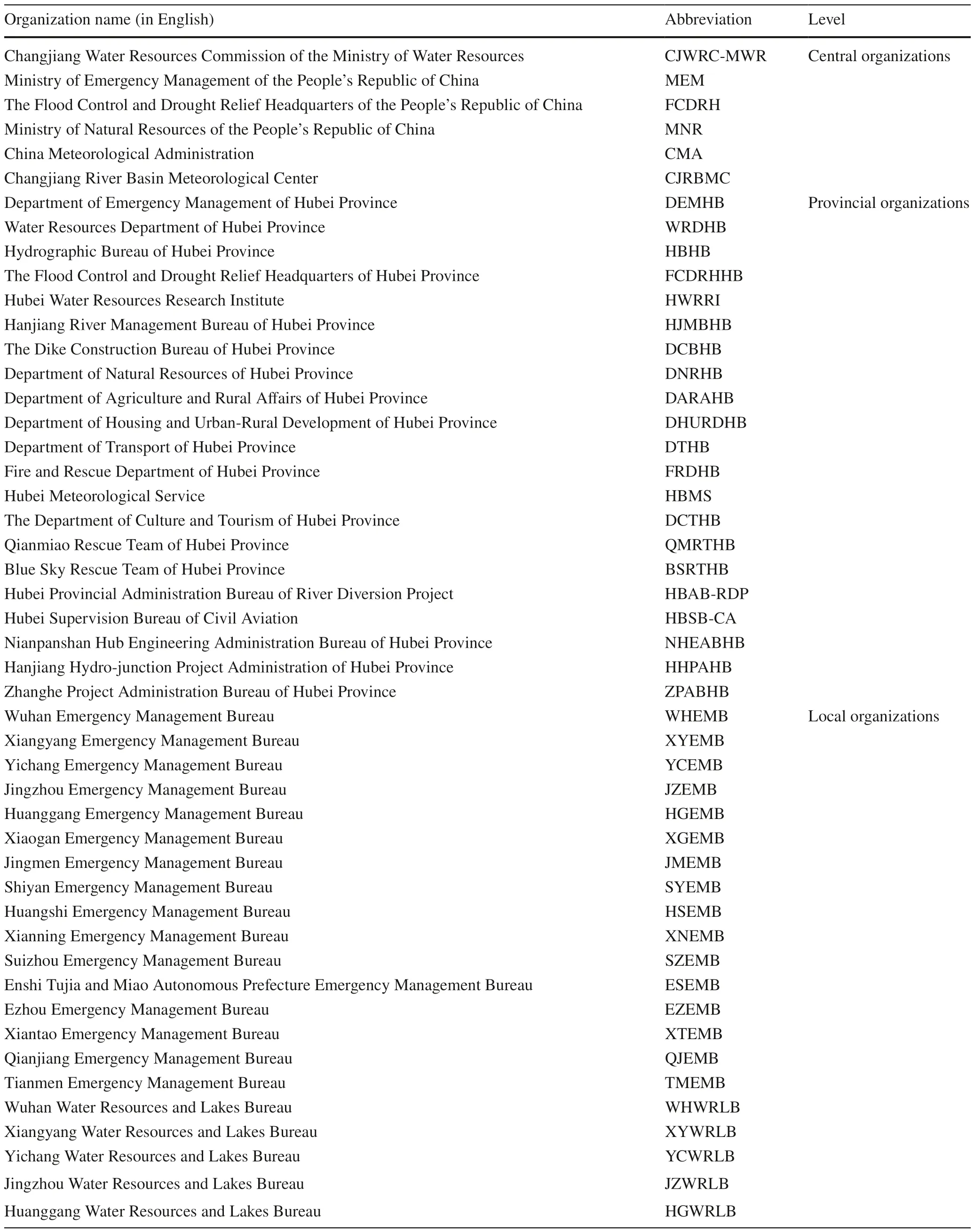
Table 2 Name and level of emergency management organizations in this study
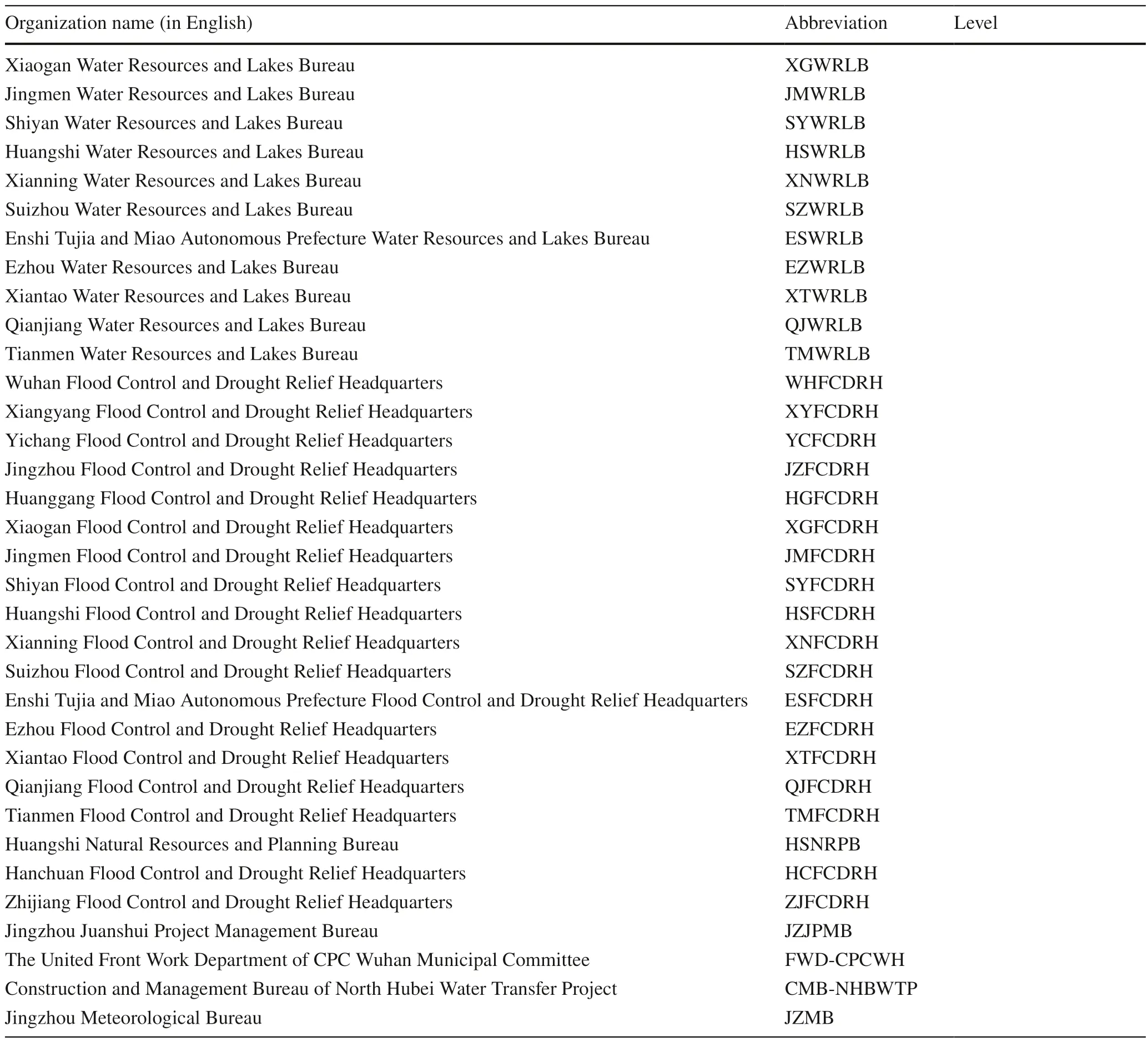
Table 2 (continued)
Collaborative network for emergency response:
4 Results and Discussion
The results of the SNA and QAP are illustrated in this section, and f igures and tables are employed to vividly describe these outcomes.
4.1 Social Network Analysis
The evolution of the network structure of interorganizational collaboration networks in the disaster preparedness and disaster response phases is demonstrated in this section.
4.1.1 Change of Network Structure
Figures 1 and 2 use the 2020 f lood disaster management data from Hubei Province to depict the organizational collaboration network in the disaster preparedness and response phases.Red represents the central-level organizations, blue represents the provincial-level organizations, and grey represents the local-level organizations.Both networks’ values are undirected.Comparing the two f igures reveals a signif icant dif ference in network density during the disaster preparedness and response phases.Signif icantly, there were more organizational node connections in the response network than in the preparedness phase, and some organizations formed new connections that did not appear in the preparedness phase.
Table 3 shows the organizational network density characteristics and number of relationships in the preparedness and response phases.Comparison of the interorganizational network characteristics showed that the network density in the response phase was 0.935, which was much higher than that in the preparedness phase (0.322).There were slightly more horizontal ties in the preparedness phase than vertical ties, and the organizational coordination was mainly horizontal, supporting H1.In the response phase, the number of vertical ties between organizations was 532, which was signif icantly greater than the number of horizontal ties; the former was nearly three times the latter.These data provisionally verify H2.These f indings indicate that the interorganizational collaboration patterns dif fered by phase: the number of interorganizational links was relatively sparse in the preparedness phase, and the horizontal links were dominated by local government organizations; more central and provincial departments were involved in the response phase,and the density of the organizational relationship networks increased.
4.1.2 Analysis of Organizational PositionsSome organizations dominated the dynamic evolution of emergency management; that is, they occupied a central position in the network and were critical actors in disaster management.Table 4 lists the top 10 organizations in terms of degree centrality in the preparedness and response phases.In the disaster preparedness phase, three were central-level organizations, two were provincial-level organizations, and most of the remaining were local-level organizations, and their overall degree centrality was not high.In the disaster response phase, there were seven central or provincial emergency response organizations, and their degree centrality was much higher than for the local organizations.The table conf irms that the central and provincial organizations occupied a central position in the f lood control and disaster relief ef forts in Hubei Province in 2020, likely due to their roles in information dissemination and resource coordination,which enhanced the density of the emergency collaboration network and strengthened the collaboration and information exchange among organizations.
We selected three centrality indicators to further analyze the structural differences in the preparedness and response networks—degree, closeness, and betweenness—and performed mean differences tests.Degree centralitymeasures the central position of an organization in the emergency network and whether it has a strong influence on the network.The higher the degree centrality in a collaborative network, the more effectively it can access critical information.Closeness centralitymeasures the centrality of a node by distance.The higher a node’s closeness centrality, the closer it is to other nodes and vice versa.Betweenness centralitymeasures the bridging role in the network.Organizations with higher betweenness centrality have more access to information and information control.Table 5 presents the results of the meanvariance test for the preparedness and response phases.The results show that both the degree centrality and the closeness centrality failed the statistical significance test;the betweenness centrality of the central and provincial emergency organizations in the disaster response phase was 1.064 higher than in the disaster preparedness phase and passed the significance test.Thus, central and provincial organizations were critical bridges during the response phase, while the local government departments actively cooperated with upper-government departments to obtain information and resources.Overall, the central and provincial organizations formed a bridging network structure and played dominant, controlling roles in the emergency management network.
4.2 Quadratic Assignment Procedure (QAP)Regression Analysis
The results of the QAP regression analysis of disaster preparedness and response phases are presented and discussed in this section; the details of these results are indicated in Tables 6, 7, 8, and 9.
4.2.1 Disaster Preparedness Phase
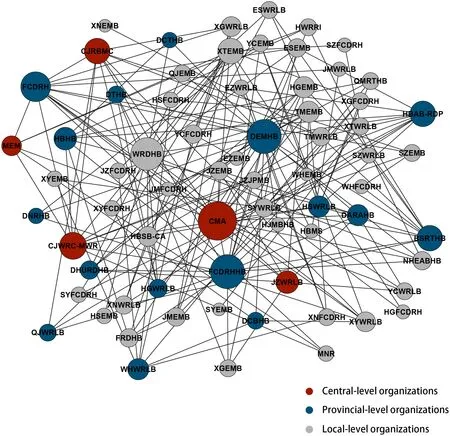
Fig.1 Organizational collaboration network for the disaster preparedness phase (N).Table 2 shows the full names of the organizations abbreviated in the f igure
We used QAP tests to identify changes in the interorganizational collaboration mechanisms during the two phases.We conducted correlation analysis to screen the explanatory variables before the QAP analysis.Table 6 shows the QAP correlation analysis of the explained and explanatory variables in the disaster preparedness phase.The results show that geographic proximity and same water system were not signif icantly correlated with the interorganizational collaboration network in the preparedness phase.This suggests that there were barriers to collaboration and a lack of stable collaboration mechanisms in geographically adjacent regions, likely due to factors such as administrative divisions and synergy of emergency plans.Therefore, our subsequent regression analysis included only four variables: horizontal linkage, vertical linkage, economic development, and population density.
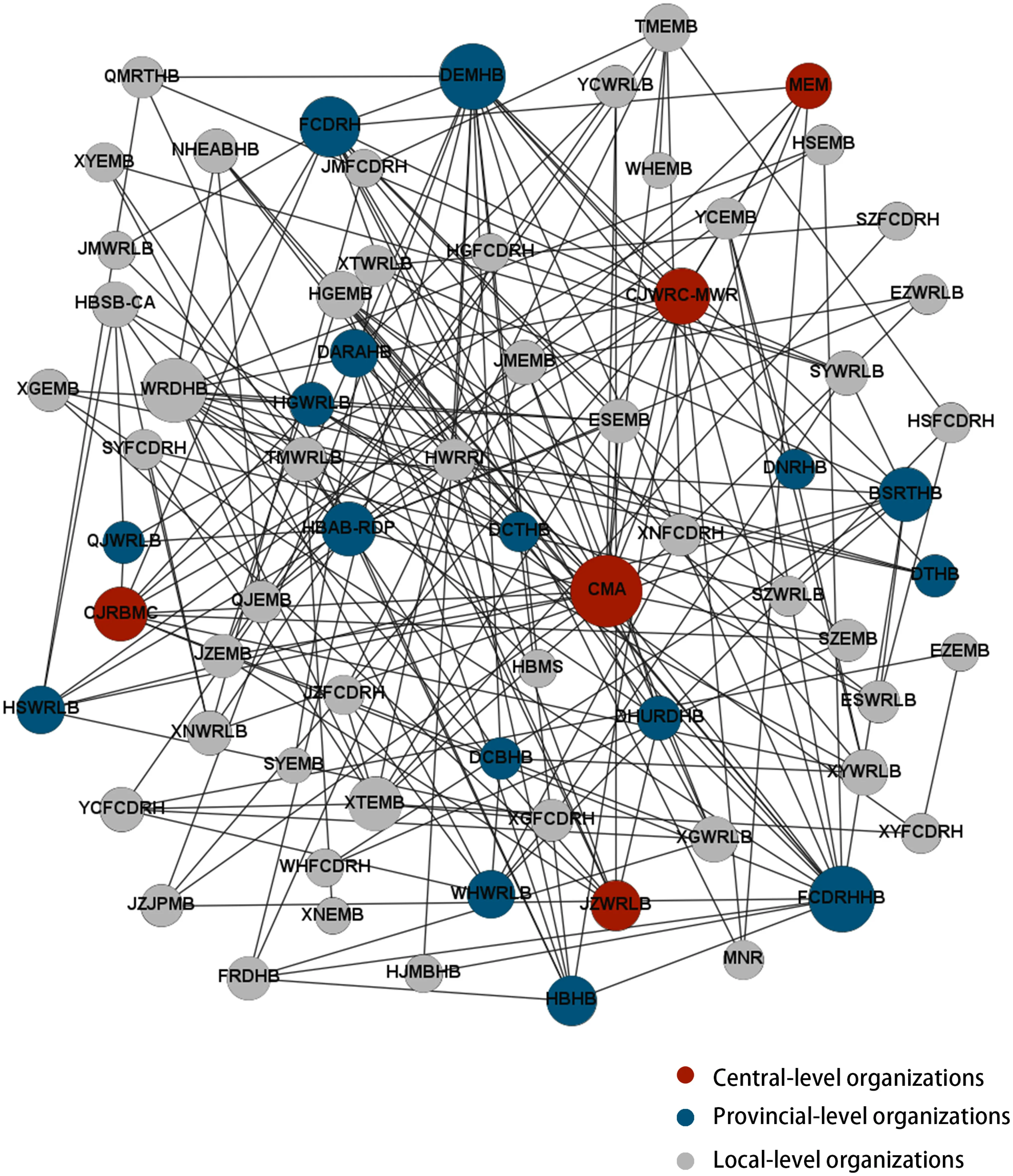
Fig.2 Organizational collaboration network for the disaster response phase (M).Table 2 shows the full names of the organizations abbreviated in the f igure
Table 7 shows the QAP regression results in disaster preparedness phase.Model 1 has only two core variables:horizontal linkage and vertical linkage.Models 2 and 3 add control variables sequentially based on model 1.The results of model 1 show that the coef ficient of horizontal linkage was 0.917; according to thep-value, horizontal collaboration had a signif icant positive ef fect on the organizational collaboration matrix at the 1% signif icance level.The coeff icient of the vertical linkage variable was negative, but thep-value results show that it was not signif icant.Models 2and 3 added control variables in turn and revealed that only the variable of horizontal linkage remained signif icant.The control variables of economic development and population density were not signif icant, and geographic location and the same water system were not relevant to the disaster preparedness phase.Therefore, we concluded that in the preparedness phase, horizontal linkages between organizations dominated, and other factors had no signif icant impact.This supports H1, meaning that in disaster preparedness, organizations adopted self-organization collaboration mechanisms and established contacts through independent consultations,with horizontal links as the main link.

Table 3 Disaster preparedness and response organizational network measurements

Table 5 Results of centrality mean dif ference tests for the preparedness and response phases
The organizations acted according to established emergency plans in the disaster preparedness phase.However,we noted a lack of synergy between the plans in dif ferentjurisdictions and fragmentations in the responsibilities and functions, posing a defection risk.China’s hierarchical structure can make sustaining ef fective collaboration among local government departments dif ficult without institutional permission and vertical embedding from the upper levels.Furthermore, ef ficient collaboration requires mutual trust formed through long-term cooperation in non-emergency situations.While f lexibility is important, the best time to form orderly, stable cooperative relationships among local organizations is during the relative calm of the f lood preparedness phase—not during the time-sensitive response phase.Although prevention has strong ef fects throughout the entire disaster management process, the disaster preparedness phase depends on the dynamics between organizations.However, a high priority is given to rescue and disposal,both in terms of the content of emergency plans and practices of emergency management, and considerable resources are invested in the response phase.
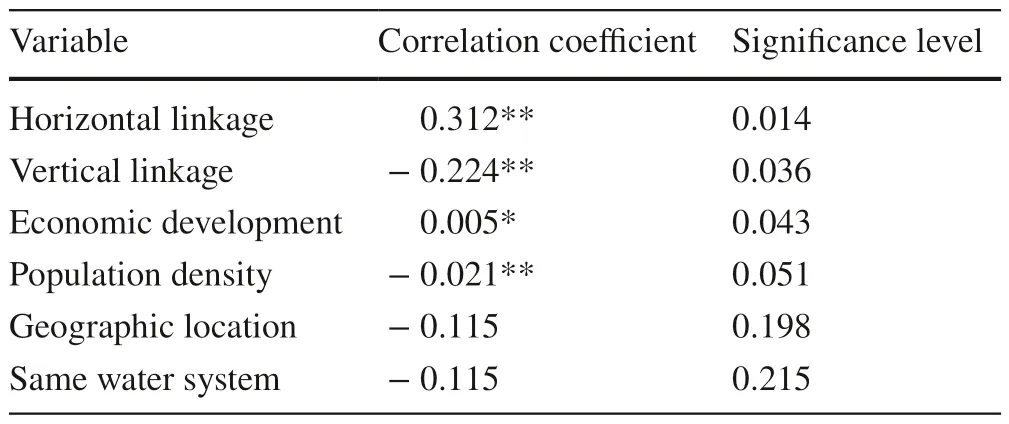
Table 6 Results of the quadratic assignment procedure (QAP) correlation analysis of disaster preparedness
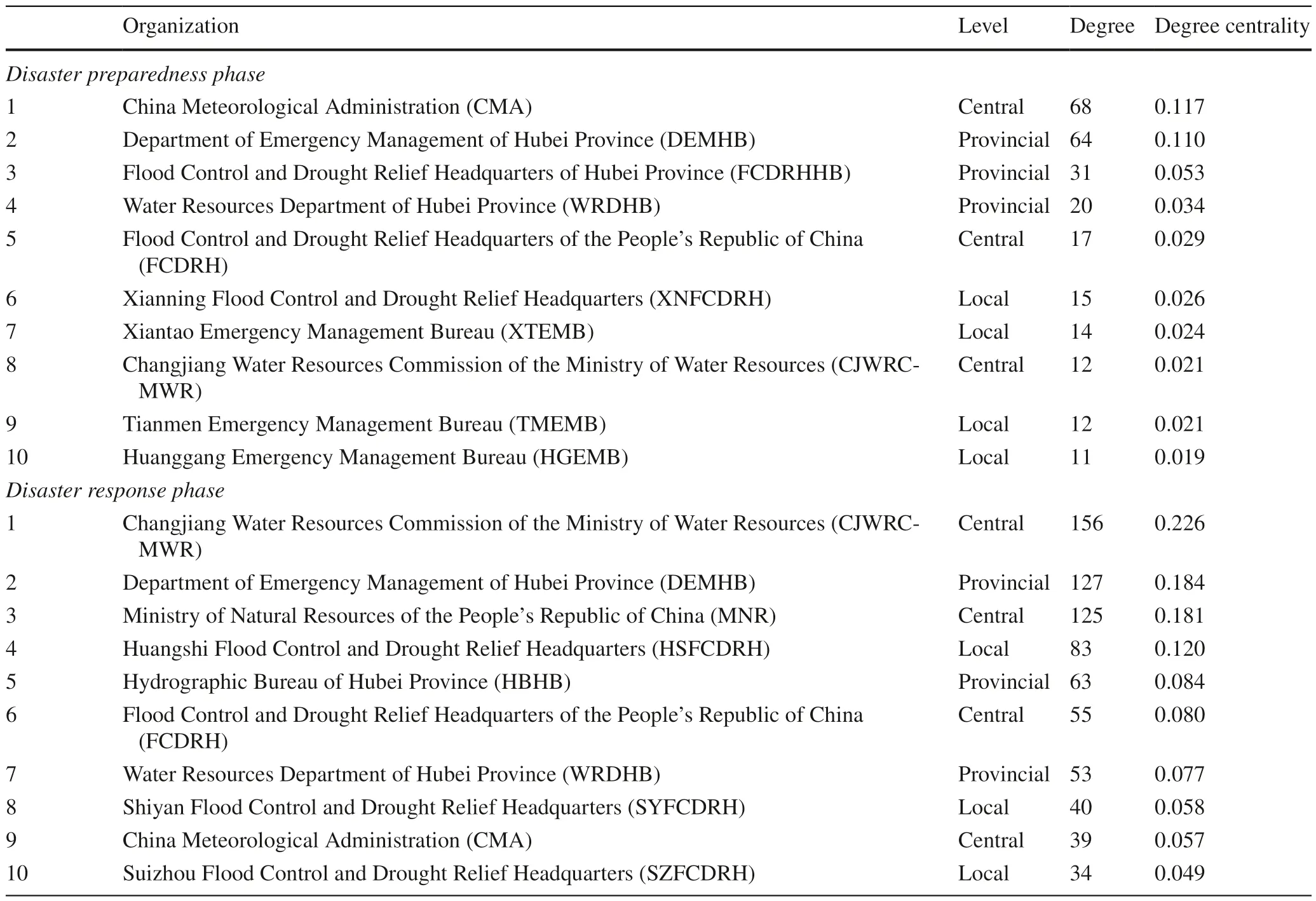
Table 4 Top 10 organizations in terms of degree centrality
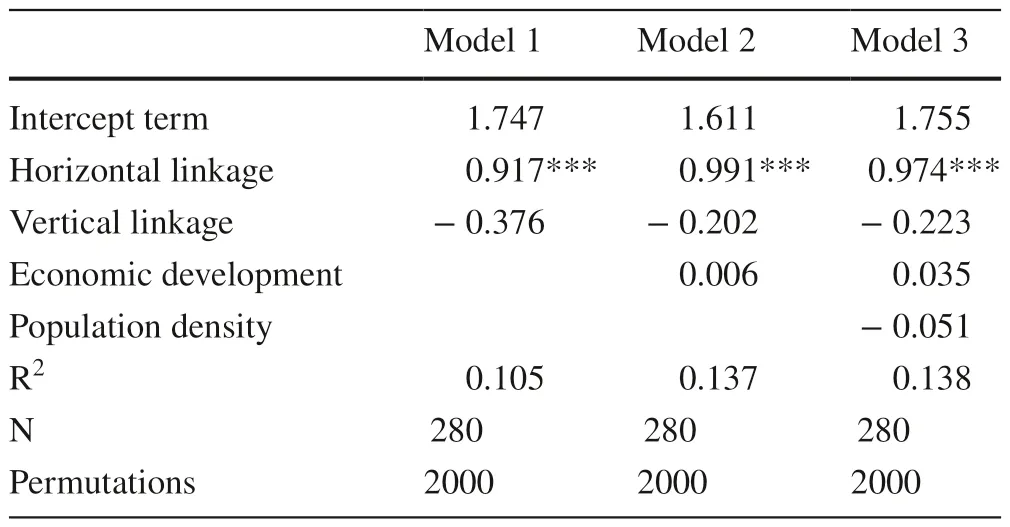
Table 7 Results of quadratic assignment procedure (QAP) regression analysis of disaster preparedness

Table 9 Results of quadratic assignment procedure (QAP) regression analysis of disaster response

Table 8 Results of quadratic assignment procedure (QAP) correlation analysis of disaster response
4.2.2 Disaster Response Phase
We used the same QAP analysis for the collaborative network in the disaster response phase as we did for the preparedness phase.Table 8 shows the QAP correlation analysis of the explained and explanatory variables in the disaster response phase; it indicates that the variable of geographic location had no signif icant correlation.Thus, we excluded it from our subsequent QAP regression analyses and used only the other f ive explanatory variables.
Table 9 shows that model 1 had only two core variables:horizontal linkages and vertical linkages.Based on thep-value, the coef ficient of the vertical linkages was 0.304 at the 1% signif icance level, which was signif icantly positive,indicating that the vertical administrative interventions had a positive impact on the formation of organizational collaborations in the disaster response phase.Models 2 to 4 incorporated the control variables in turn, where both the coef ficients of horizontal linkage and vertical linkage were statistically signif icant.This shows that the vertical relationship between governments was a critical factor inf luencing interorganizational collaboration during the disaster response phase, with the central and provincial government departments having closer vertical ties with other government departments.Unlike population density, which is not signif icant in Models 3 and 4, economic development had a signif icant impact on the formation of interorganizational collaboration in the disaster response phase.It ref lected the fundamental role of economic conditions during interorganizational collaboration in the disaster response phase.Incorporating the variable of having the same water system,model 4 showed that the adjacency of the same water projects and rivers had a positive ef fect on the disaster response network; provincial and central organizations actively sent working groups to support local disaster management.Because of the intervention of upper-level organizations,the local organizations could break through the barriers of territorial management based on the adjacency to rivers and reservoirs.This f inding supports H2.
Unlike the QAP regression analysis for the disaster preparedness phase, the QAP analysis for disaster response showed that both horizontal and vertical linkages had a signif icant positive ef fect.The central and provincial organizations were actively embedded and sunk into the collaborative network of local organizations.This variable and having the same water system were signif icant, indicating that the central and provincial organizations acted as “bridges” that mitigated the fragmentation between local organizations.The QAP regression analyses of the f lood preparedness and response phases showed that the collaboration mechanisms of organizations evolved dynamically, with more horizontal interorganizational collaborations in the disaster preparedness phase but shifting more to vertical interorganizational collaborations in the disaster response phase.
5 Conclusion
Ef fective collaboration among organizations provides an important foundation for national disaster management.Previous research has emphasized the importance of focusing on emergency management network structures from a dynamic perspective (Abbasi and Kapucu 2012) and the structure and collaborative response to disaster appropriation (Ku et al.2021).
This study used the SNA to dynamically analyze the interorganizational collaboration networks across the preparedness and response phases of the 2020 f loods in Hubei Province, China.We found that the density of interorganizational collaboration networks changed between the two phases; the network density was higher in the response phase than in the preparedness phase.This result implies that although the organizations had prepared for a disaster with emergency plans, the original linkage collaborations were insuf ficient to mount the necessary response to f looding of that magnitude.Thus, some organizations formed new links during the response phase.Our results dif fered from those focusing on other countries such as South Korea (Song and Jung 2015) for several reasons.First, China established its emergency management system much more recently, so it has had less time for ref inements and completion.Second,China’s disaster management follows the command principle of “hierarchical responsibility and local management.” The resources from the central and upper levels are often embedded in the response according to the disaster situation.To a certain extent, the central vertical intervention controls and dominates the response phase.
This study incorporated two main collaboration variables, vertical and horizontal linkages, to investigate the transformation of collaborative organizational mechanisms.We used the CAS theory to examine the dynamics of interorganizational collaboration, including the level of collaboration objectives and requirements, in two dif ferent phases.We found that the disaster preparedness phase planned and established the collaborations and chose self-organizational collaboration mechanisms,with local government organizations predominantly linked horizontally.Thus, the disaster response phase followed the plans, implementing the interorganizational collaborations—until the magnitude of the need called for more information and resources from the central and provincial departments embedded in the local f lood response.Thus,the organizational relationships in the disaster response phase were predominantly linked vertically.
However, limited by institutional compartmentalization and territorial barriers, horizontal collaboration among organizations lacked the overall synergy necessary for high performance.Local governments were fragmented in terms of information, resources, and responsibilities.This highlights a limitation of the current emergency management mechanisms in China, namely, that its preparedness, early warning, and monitoring development is lagging.There is also a gap between the preparation of emergency plans and the deployment of emergency response.In the disaster response phase, the central and provincial organizations actively collaborated, mobilized from the top down, and shifted their organizations, authority, and responsibilities,which helped overcome the drawbacks of highly decentralized local management.Therefore, our f indings contribute to the emergency management literature by examining the dynamic evolution of interorganizational collaboration networks before and after a disaster and the dif ferences in organizational collaboration patterns.
This study had the following limitations.First, our data were limited to of ficial government news reports and government-published data.Future studies should consider adding more data sources, including interviews.Second, this study focused only on government organizational networks and not the network relationships of other organization types, such as non-governmental organizations.Future studies should be expanded to include those.We recommend follow-up studies broadening the analysis to dif ferent levels and types of organizations to form a richer and more diversif ied network structure and explore the dynamic processes of government and social organizations in disaster management.
AcknowledgmentsThis study was supported by the National Natural Science Foundation of China (Grant No.71974057, 72374132),the Shu Guang Project (Grant No.21SG49), the Ministry of Education through the Humanities and Social Science Project (Grant No.19YJC630104), the Shanghai Municipal Education Commission, and the Shanghai Education Development Foundation.The authors are deeply grateful for these supports.
Open AccessThis article is licensed under a Creative Commons Attribution 4.0 International License, which permits use, sharing, adaptation, distribution and reproduction in any medium or format, as long as you give appropriate credit to the original author(s) and the source,provide a link to the Creative Commons licence, and indicate if changes were made.The images or other third party material in this article are included in the article's Creative Commons licence, unless indicated otherwise in a credit line to the material.If material is not included in the article's Creative Commons licence and your intended use is not permitted by statutory regulation or exceeds the permitted use, you will need to obtain permission directly from the copyright holder.To view a copy of this licence, visit http:// creat iveco mmons.org/ licen ses/ by/4.0/.
杂志排行
International Journal of Disaster Risk Science的其它文章
- Navigating Interoperability in Disaster Management: Insights of Current Trends and Challenges in Saudi Arabia
- Community Insights: Citizen Participation in Kamaishi Unosumai Decade-Long Recovery from the Great East Japan Earthquake
- Mapping Seismic Hazard for Canadian Sites Using Spatially Smoothed Seismicity Model
- Identifying Neighborhood Ef fects on Geohazard Adaptation in Mountainous Rural Areas of China: A Spatial Econometric Model
- Damage Curves Derived from Hurricane Ike in the West of Galveston Bay Based on Insurance Claims and Hydrodynamic Simulations
- A Deep Learning Application for Building Damage Assessment Using Ultra-High-Resolution Remote Sensing Imagery in Turkey Earthquake
